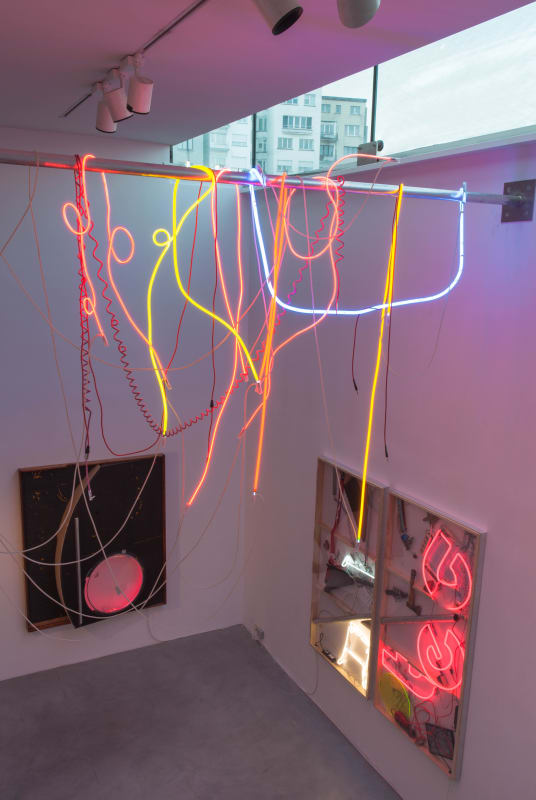The Galerie Nathalie Obadia is very pleased to present the second solo exhibition of Joris Van de Moortel in Brussels.
The title of the exhibition – “It’s no longer a thing but a performance group” – sounds like a declaration by the artist and informs the public of one of the keys to understanding the protean work of this young Flemish artist, whose artistic uniqueness is drawn from the collective energy of performance.
Joris Van de Moortel is as much a visual artist as a musician. For him the transition from one to the other occurs through performance, in which live music is a crucial component of both his practice and creative logic.
An ardent admirer of German Romanticism, Joris Van de Moortel has the same desire for intense experiences and emotions as the artists of the nineteenth century. Whereas the painter Kaspar David Friedrich attempted to record on canvas the tempestuous feelings aroused in him by the immensity of the sea, Joris Van de Moortel places himself in danger during each of his performances. Improvised rather than planned, it is the risk involved that gives the artist the powerful sensations he seeks to trigger the creative process in his works.
One of his favourite “instruments” is the Cylinder, a giant tube inside which he installs the mobile stage for his performances. Since 2012, the date of its first presentation at Le Transpalette art centre in Bourges, this artistic and sonic UFO has not ceased to evolve, changing with every ephemeral setting that it is set up in.
Following a presentation that garnered attention at the Palais de Tokyo in Paris in 2014, the Cylinder has recently made the walls reverberate at Villa Empain in Brussels during the group exhibition “Music Palace, The power of music seen by visual artists”.
The performance always starts with the crashing sounds of the guitars, which take Joris Van de Moorel into a sort of hypnotic trance. It is the trance that directs the acts of destruction that are then visited on the instruments, amplifiers, microphones and electric cables before the artist turns on the Cylinder itself.
The mutilated set is often spattered with indelible marks of paint or glue that become added to the other stigmata resulting from the performance.
But although everything is smashed, nothing is lost. Once he is back in the solitude of his studio, Joris Van de Moortel recycles this “debris”, which in fact provides him with the raw material of his works.
Each element owes its preservation to the cathartic charge that it contains through its role as a memory of the performance. So that this is not lost, Joris Van de Moortel confines these objects-cum-attestation inside transparent cases. He thus reproduces the chaos that brought them into being while placing careful emphasis on how they appear inside the restrictive frame of the work.
The rigour with which he treats their presentation is common to all the works displayed at the galerie Nathalie Obadia. Joris Van de Moortel achieves this with an unexpected sense of harmony, as in this composition that combines a circle and a straight line with Constructivist precision.
He is also capable of refinement, all the more so when he uses neon with the same deftness as watercolours. The “trace of electric light” escapes the limits of the work in the same way that water-paints overflow a contour.
The selection of works that Joris Van de Moortel has chosen to show at the galerie Nathalie Obadia explores two new paths of pictorial research that may seem divergent at first glance.
The first is expressed through drawing, a technique used here for its figurative and narrative capacities. The second runs counter to the first by establishing objects and colours within abstract compositions.
From the cases – relics of the performance – to the marks left by the performer, there is only one step, which the artist takes cheerfully. Through digression and humour, Joris Van de Moortel injects his work with a poetic and cathartic dimension that associates him with Marcel Duchamp and Marcel Broodthaers. In offering us his own version of a readymade, the Belgian artist invites us to enter his creative universe. Its innate precariousness lays bare the permanent tension that exists between the order and chaos that preside in both his plastic and musical work.
In November 2015 the BE-PART contemporary art centre in Waregem near Ghent (Belgium) will present the first institutional exhibition of the work of Joris Van de Moortel in Belgium.
Joris Van de Moortel: It’s no longer a thing but a performance group
Past exhibition
22 Avril - 30 Mai 2015
Charles Decoster - Brussels

